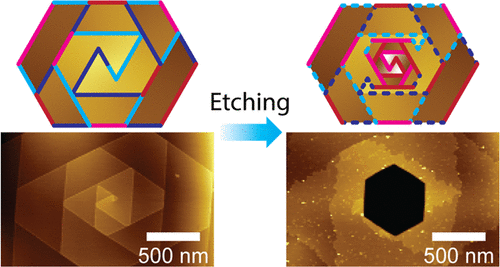当前位置:
X-MOL 学术
›
Nano Lett.
›
论文详情
Our official English website, www.x-mol.net, welcomes your feedback! (Note: you will need to create a separate account there.)
Chemical Etching of Screw Dislocated Transition Metal Dichalcogenides
Nano Letters ( IF 10.8 ) Pub Date : 2021-09-07 , DOI: 10.1021/acs.nanolett.1c02799 Yuzhou Zhao 1 , Xiao Kong 2 , Melinda J Shearer 1 , Feng Ding 2, 3 , Song Jin 1
Nano Letters ( IF 10.8 ) Pub Date : 2021-09-07 , DOI: 10.1021/acs.nanolett.1c02799 Yuzhou Zhao 1 , Xiao Kong 2 , Melinda J Shearer 1 , Feng Ding 2, 3 , Song Jin 1
Affiliation

|
Chemical etching can create novel structures inaccessible by growth and provide complementary understanding on the growth mechanisms of complex nanostructures. Screw dislocation-driven growth influences the layer stackings of transition metal dichalcogenides (MX2) resulting in complex spiral morphologies. Herein, we experimentally and theoretically study the etching of screw dislocated WS2 and WSe2 nanostructures using H2O2 etchant. The kinetic Wulff constructions and Monte Carlo simulations establish the etching principles of single MX2 layers. Atomic force microscopy characterization reveals diverse etching morphology evolution behaviors around the dislocation cores and along the exterior edges, including triangular, hexagonal, or truncated hexagonal holes and smooth or rough edges. These behaviors are influenced by the edge orientations, layer stackings, and the strain of screw dislocations. Ab initio calculation and kinetic Monte Carlo simulations support the experimental observations and provide further mechanistic insights. This knowledge can help one to understand more complex structures created by screw dislocations through etching.
中文翻译:

螺旋位错过渡金属二硫属化物的化学蚀刻
化学蚀刻可以创造生长无法达到的新结构,并提供对复杂纳米结构生长机制的补充理解。螺旋位错驱动的生长影响过渡金属二硫属化物 (MX 2 )的层堆叠,导致复杂的螺旋形貌。在此,我们从实验和理论上研究了使用 H 2 O 2蚀刻剂对螺旋位错 WS 2和 WSe 2纳米结构的蚀刻。动力学 Wulff 结构和 Monte Carlo 模拟建立了单个 MX 2的蚀刻原理层。原子力显微镜表征揭示了位错核心周围和沿外边缘的不同蚀刻形态演化行为,包括三角形、六边形或截头六边形孔以及光滑或粗糙的边缘。这些行为受边缘取向、层堆叠和螺位错应变的影响。从头计算和动力学蒙特卡罗模拟支持实验观察并提供进一步的机械见解。这一知识可以帮助人们理解由螺旋位错通过蚀刻产生的更复杂的结构。
更新日期:2021-09-22
中文翻译:

螺旋位错过渡金属二硫属化物的化学蚀刻
化学蚀刻可以创造生长无法达到的新结构,并提供对复杂纳米结构生长机制的补充理解。螺旋位错驱动的生长影响过渡金属二硫属化物 (MX 2 )的层堆叠,导致复杂的螺旋形貌。在此,我们从实验和理论上研究了使用 H 2 O 2蚀刻剂对螺旋位错 WS 2和 WSe 2纳米结构的蚀刻。动力学 Wulff 结构和 Monte Carlo 模拟建立了单个 MX 2的蚀刻原理层。原子力显微镜表征揭示了位错核心周围和沿外边缘的不同蚀刻形态演化行为,包括三角形、六边形或截头六边形孔以及光滑或粗糙的边缘。这些行为受边缘取向、层堆叠和螺位错应变的影响。从头计算和动力学蒙特卡罗模拟支持实验观察并提供进一步的机械见解。这一知识可以帮助人们理解由螺旋位错通过蚀刻产生的更复杂的结构。



























 京公网安备 11010802027423号
京公网安备 11010802027423号